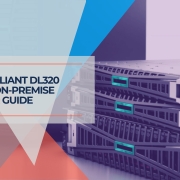The Limitations of On-Premise IT Solutions for Small Businesses
Published: 2023-01-23 | Last updated: September 2025
Key Takeaway: While on-premise servers offer direct control, they create significant barriers to growth through limited scalability, high maintenance costs, security vulnerabilities, and reliability challenges. Modern cloud-based solutions provide more flexible, cost-effective alternatives that better support business growth and operational efficiency.
Table of Contents
- 1 Introduction
- 2 Understanding On-Premise Infrastructure
- 3 Scalability and Flexibility Constraints
- 4 Financial Burden and Hidden Costs
- 5 Security Vulnerabilities and Management Challenges
- 6 Reliability and Disaster Recovery Limitations
- 7 Modern Cloud-Based Alternatives
- 8 Making the Transition Decision
- 9 Conclusion
- 10 Frequently Asked Questions
- 10.0.1 What are the main signs that on-premise infrastructure is holding back my business?
- 10.0.2 How do I calculate the true cost of my on-premise infrastructure?
- 10.0.3 Is cloud infrastructure really more secure than on-premise solutions?
- 10.0.4 Can I maintain some on-premise infrastructure while using cloud services?
- 10.0.5 What happens to my data if I switch from on-premise to cloud solutions?
- 10.0.6 How long does it typically take to transition away from on-premise infrastructure?
Introduction
On-premise servers remain a common choice for small businesses seeking direct control over their IT infrastructure. These systems, typically running Windows Server or Linux distributions, handle critical functions like file storage, email hosting, application servers, and database management from within the company's physical location.
However, as businesses face increasing demands for flexibility, remote work capabilities, and rapid scaling, traditional on-premise infrastructure often becomes a constraint rather than an asset. The challenges extend beyond simple technical limitations to encompass financial burden, operational complexity, and strategic inflexibility that can significantly impact a company's ability to compete and grow.
Understanding these limitations is crucial when developing a comprehensive technology strategy that supports rather than hinders business objectives. This analysis examines the primary constraints of on-premise solutions and explores how modern alternatives address these fundamental challenges.
Understanding On-Premise Infrastructure
On-premise solutions involve hosting IT infrastructure within a business's physical premises, requiring the organization to manage hardware, software, maintenance, and security entirely in-house or through local IT support providers.
Common On-Premise Server Platforms
Microsoft Windows Server
Windows Server remains popular among small businesses due to its integration with Microsoft Office environments. It provides Active Directory for user management, Group Policy for system configuration, Remote Desktop Services for remote access, and built-in support for Microsoft applications like Exchange Server and SharePoint.
Linux Server Distributions
Linux offers a cost-effective alternative with distributions like Ubuntu Server, Red Hat Enterprise Linux, Debian, and CentOS. These systems provide stability, security, and flexibility for web servers, databases, and custom applications, though they typically require more technical expertise to manage effectively.
Specialized Server Appliances
Some businesses deploy dedicated appliances for specific functions like Network Attached Storage (NAS), email servers, or customer relationship management systems. While focused in purpose, these still require the same infrastructure considerations as general-purpose servers.
Scalability and Flexibility Constraints
The most significant limitation of on-premise infrastructure lies in its inability to adapt quickly to changing business needs. This inflexibility manifests in several critical areas that directly impact business operations and growth potential.
Hardware Capacity Limitations
On-premise servers operate within fixed hardware constraints. When a business experiences growth, seasonal demand spikes, or needs to deploy new applications, the existing infrastructure may lack sufficient processing power, memory, or storage capacity.
Upgrading hardware requires significant planning, procurement time, and often complete system downtime. A typical server upgrade cycle involves weeks of planning, hardware ordering, installation scheduling, data migration, and testing—during which business operations may be disrupted or constrained.
Real-World Impact
Consider a growing accounting firm that needs additional server capacity during tax season. With on-premise infrastructure, they must either over-provision year-round (wasting resources and money) or accept performance degradation during peak periods. Neither option supports optimal business operations.
Geographic and Remote Access Challenges
On-premise servers create inherent limitations for businesses with multiple locations or remote workers. Accessing company resources requires complex VPN configurations, dedicated internet connections, or expensive wide-area networking solutions.
These solutions often introduce performance bottlenecks, security vulnerabilities, and additional maintenance overhead. Remote workers may experience slow file access, unreliable connections, and limited functionality compared to in-office users.
Application and Service Integration Difficulties
Modern business applications increasingly rely on cloud-based services and APIs. On-premise infrastructure can create integration challenges when connecting to external services, implementing modern authentication methods, or adopting new software solutions that expect cloud-native environments.
This limitation becomes particularly problematic when businesses want to adopt Software-as-a-Service (SaaS) applications that require seamless data synchronization or single sign-on capabilities with existing systems.
Financial Burden and Hidden Costs
The total cost of ownership for on-premise infrastructure extends far beyond initial hardware and software purchases. Many businesses underestimate the ongoing financial commitment required to maintain effective on-premise operations.
Capital Expenditure Requirements
On-premise solutions require significant upfront investment in hardware, software licenses, networking equipment, and infrastructure preparation. These capital expenditures often strain small business budgets and tie up resources that could be invested in core business activities.
| Cost Category | Initial Investment | Annual Ongoing |
|---|---|---|
| Server Hardware | $3,000 – $15,000+ | $500 – $2,000 (maintenance) |
| Software Licenses | $1,000 – $5,000+ | $200 – $1,500 (renewals) |
| Networking & Infrastructure | $1,500 – $8,000 | $300 – $1,200 |
| IT Management | $2,000 – $10,000 | $6,000 – $50,000+ |
Operational Expenses
Beyond initial costs, on-premise infrastructure generates continuous operational expenses that many businesses fail to anticipate fully:
- Electricity and Cooling: Servers consume power continuously and generate heat requiring climate control
- Internet and Networking: Dedicated business internet connections with sufficient bandwidth for server operations
- Physical Security: Secure server rooms, access controls, and environmental monitoring
- Insurance: Additional coverage for valuable IT equipment and data liability
- Backup and Disaster Recovery: Backup systems, offsite storage, and recovery procedures
Staffing and Expertise Costs
On-premise infrastructure requires ongoing technical expertise that small businesses often struggle to provide cost-effectively. Options include hiring full-time IT staff, contracting with managed service providers, or burdening existing employees with technical responsibilities beyond their primary roles.
Each approach carries significant costs and potential risks. Full-time IT staff represent substantial salary and benefit expenses for capabilities that may not be needed full-time. Managed service providers charge premium rates for specialized expertise, while untrained staff managing IT systems often leads to security vulnerabilities and operational problems.
Security Vulnerabilities and Management Challenges
On-premise infrastructure places the full burden of cybersecurity on the business, requiring expertise and resources that many small organizations lack. This responsibility encompasses multiple layers of security that must be maintained continuously and updated regularly.
Physical Security Requirements
On-premise servers require physical security measures to prevent unauthorized access, theft, or tampering. This includes secure server rooms, access controls, surveillance systems, and environmental monitoring to prevent damage from temperature, humidity, or water exposure.
Many small businesses inadequately address physical security, leaving servers in unsecured locations like closets, basements, or general office areas where they remain vulnerable to both intentional and accidental damage.
Network Security Complexity
Protecting on-premise infrastructure requires comprehensive network security including firewalls, intrusion detection systems, network segmentation, and continuous monitoring. These systems must be configured correctly, updated regularly, and monitored for threats.
Common Security Gaps
Patch Management: Operating systems and applications require regular security updates that must be tested and applied systematically.
Access Control: User permissions must be managed carefully to ensure appropriate access levels without compromising security.
Backup Security: Backup systems themselves become targets and require protection against ransomware and data theft.
Remote Access: VPN and remote desktop solutions create additional attack vectors that must be secured and monitored.
Compliance and Regulatory Challenges
Businesses handling sensitive data must comply with regulations like HIPAA, PCI DSS, GDPR, or industry-specific requirements. On-premise infrastructure places the full burden of compliance on the business, requiring documentation, auditing, and technical controls that can be expensive and complex to implement properly.
Cloud providers often offer compliance frameworks and certifications that are difficult and expensive for small businesses to achieve independently with on-premise infrastructure.
Reliability and Disaster Recovery Limitations
On-premise infrastructure creates single points of failure that can significantly impact business operations. Unlike cloud providers with redundant systems across multiple data centers, small businesses typically lack the resources to implement comprehensive redundancy and disaster recovery capabilities.
Hardware Failure Risks
Server hardware components inevitably fail over time. Hard drives, power supplies, memory modules, and other components have finite lifespans and can fail unexpectedly. When critical hardware fails, businesses may experience extended downtime while replacement parts are procured and installed.
Small businesses rarely maintain spare hardware inventory due to cost considerations, meaning hardware failures often result in days or weeks of reduced functionality while repairs are completed.
Environmental and Infrastructure Dependencies
On-premise servers depend on local infrastructure that businesses cannot control. Power outages, internet service disruptions, HVAC failures, or natural disasters can render on-premise infrastructure inaccessible or damaged.
- Power Dependencies: Servers require continuous power with backup systems (UPS, generators), adding cost and complexity
- Internet Connectivity: Business operations depend on reliable internet service that may be disrupted by weather, construction, or provider issues
- Climate Control: Servers generate heat and require consistent temperature and humidity control to operate reliably
- Natural Disasters: Floods, fires, storms, or other disasters can destroy on-premise infrastructure entirely
Backup and Recovery Complexity
Effective disaster recovery requires multiple backup copies stored in different locations, regular testing of recovery procedures, and documented processes for restoring operations. Implementing comprehensive backup and recovery for on-premise infrastructure requires significant technical expertise and ongoing management.
Many small businesses implement inadequate backup solutions that fail during actual recovery scenarios, discovering too late that their backup systems were incomplete, corrupted, or inaccessible when needed most.
Modern Cloud-Based Alternatives
Cloud computing has evolved to address the fundamental limitations of on-premise infrastructure while providing capabilities that were previously available only to large enterprises with substantial IT budgets.
Infrastructure as a Service (IaaS)
IaaS solutions provide virtualized computing resources that can be scaled instantly based on demand. Businesses can deploy virtual servers, storage, and networking components without purchasing physical hardware or managing underlying infrastructure.
Leading IaaS providers offer enterprise-grade infrastructure with redundancy, security, and performance that would be prohibitively expensive for small businesses to implement independently.
Software as a Service (SaaS)
SaaS applications eliminate the need for on-premise application servers entirely. Email, customer relationship management, accounting, project management, and other business applications can be accessed through web browsers without local installation or maintenance.
SaaS solutions typically include automatic updates, security patches, backup services, and technical support as part of the subscription, reducing the technical burden on small businesses significantly.
Platform as a Service (PaaS)
For businesses with custom application requirements, PaaS solutions provide development and deployment platforms without the complexity of managing underlying infrastructure. This enables businesses to focus on application functionality rather than server management.
- Instant Scalability: Resources can be increased or decreased based on actual demand without hardware procurement
- Geographic Distribution: Applications and data can be distributed globally for better performance and reliability
- Automatic Updates: Security patches and software updates are managed by the provider
- Built-in Redundancy: Multiple data centers and automatic failover provide superior reliability
- Predictable Costs: Monthly subscription models eliminate large capital expenditures and provide predictable budgeting
Making the Transition Decision
The decision to move away from on-premise infrastructure should be based on careful analysis of business requirements, current limitations, and long-term strategic goals. Not all businesses need to eliminate on-premise infrastructure entirely, but most can benefit from hybrid approaches that leverage cloud services for appropriate use cases.
Assessment Framework
Current State Analysis
Evaluate existing infrastructure costs, performance limitations, security gaps, and operational challenges. Document actual total cost of ownership including hidden costs like staff time, utilities, and opportunity costs.
Business Requirements Review
Identify current and future business needs, including scalability, remote access, compliance obligations, and integration requirements with other business systems.
Risk Assessment
Compared to cloud alternatives, analyze risks associated with current infrastructure, including security vulnerabilities, disaster recovery gaps, and business continuity threats.
Financial Comparison
Compare the total cost of ownership for on-premise solutions versus cloud alternatives over multiple years, including both direct costs and indirect costs like staff time and opportunity costs.
Migration Strategies
Businesses can adopt various approaches to transitioning away from on-premise limitations:
Gradual Migration: Move applications and services to cloud solutions incrementally, starting with less critical systems to gain experience and confidence.
Hybrid Approach: Maintain some on-premise infrastructure while leveraging cloud services for specific functions like email, backup, or application hosting.
Complete Cloud Adoption: Eliminate on-premise infrastructure entirely in favor of cloud-based solutions for all business functions.
Conclusion
While offering direct control, on-premise server infrastructure creates significant barriers to business growth and operational efficiency. The limitations in scalability, high total cost of ownership, security management complexity, and reliability challenges often outweigh the perceived benefits of local control.
Modern cloud-based alternatives address these fundamental limitations while providing capabilities that enable businesses to focus on their core competencies rather than IT infrastructure management. The shift from capital expenditure to operational expenditure models, combined with professional-grade infrastructure and security, makes cloud solutions increasingly attractive for small businesses.
The decision to move away from on-premise infrastructure should be based on careful analysis of business needs, current limitations, and strategic objectives. However, for most small businesses, some combination of cloud services will provide better scalability, security, reliability, and cost-effectiveness than maintaining a comprehensive on-premise infrastructure.
Success in today's competitive business environment increasingly depends on agility, efficiency, and the ability to leverage technology as a strategic advantage rather than an operational burden. Understanding the limitations of on-premise solutions is the first step toward making informed decisions about technology infrastructure that supports rather than constrains business growth.
Frequently Asked Questions
What are the main signs that on-premise infrastructure is holding back my business?
Key indicators include difficulty scaling during busy periods, high IT maintenance costs relative to business size, frequent downtime or performance issues, challenges supporting remote workers, difficulty integrating new software solutions, and spending more time managing IT than focusing on core business activities.
How do I calculate the true cost of my on-premise infrastructure?
Include hardware costs, software licenses, electricity and cooling, internet connectivity, physical space rental value, IT staff time or contractor costs, backup and security systems, insurance, and opportunity costs of staff time spent on IT issues. Many businesses find their actual costs are 2-3 times higher than initially estimated.
Is cloud infrastructure really more secure than on-premise solutions?
For most small businesses, yes. Cloud providers invest heavily in security infrastructure, employ dedicated security teams, maintain compliance certifications, and provide automatic security updates. Small businesses rarely have the resources to match enterprise-grade security measures that cloud providers implement as standard practice.
Can I maintain some on-premise infrastructure while using cloud services?
Absolutely. Hybrid approaches are common and often practical. You might keep local file servers for performance while moving email to the cloud, or maintain on-premise databases while using cloud-based applications. The key is choosing the right solution for each specific business function.
What happens to my data if I switch from on-premise to cloud solutions?
Data migration is typically handled through structured processes provided by cloud vendors or IT service providers. Data can be transferred securely, and most cloud providers offer better backup and disaster recovery capabilities than small businesses can implement independently. Always verify data portability and backup procedures before making changes.
How long does it typically take to transition away from on-premise infrastructure?
Timeline varies significantly based on complexity and approach. Simple migrations like email or basic applications can be completed in weeks, while comprehensive infrastructure changes may take several months. Gradual migration approaches allow businesses to transition at their own pace while maintaining operations throughout the process.






Leave a Reply
Want to join the discussion?Feel free to contribute!